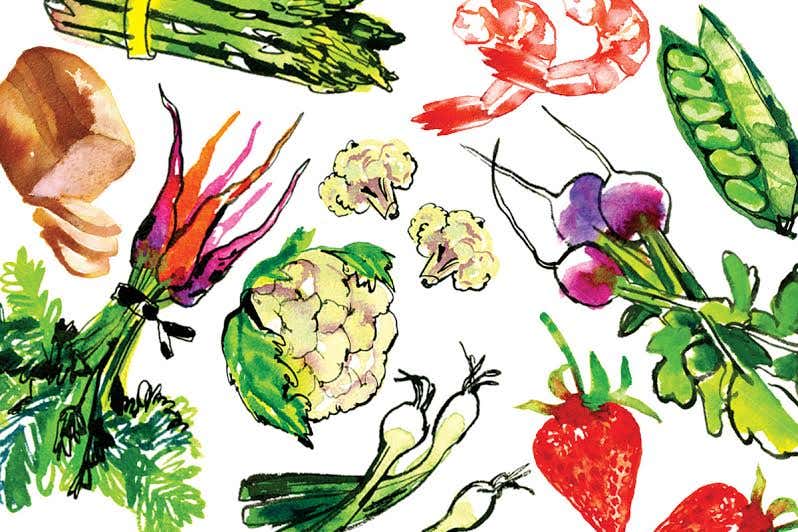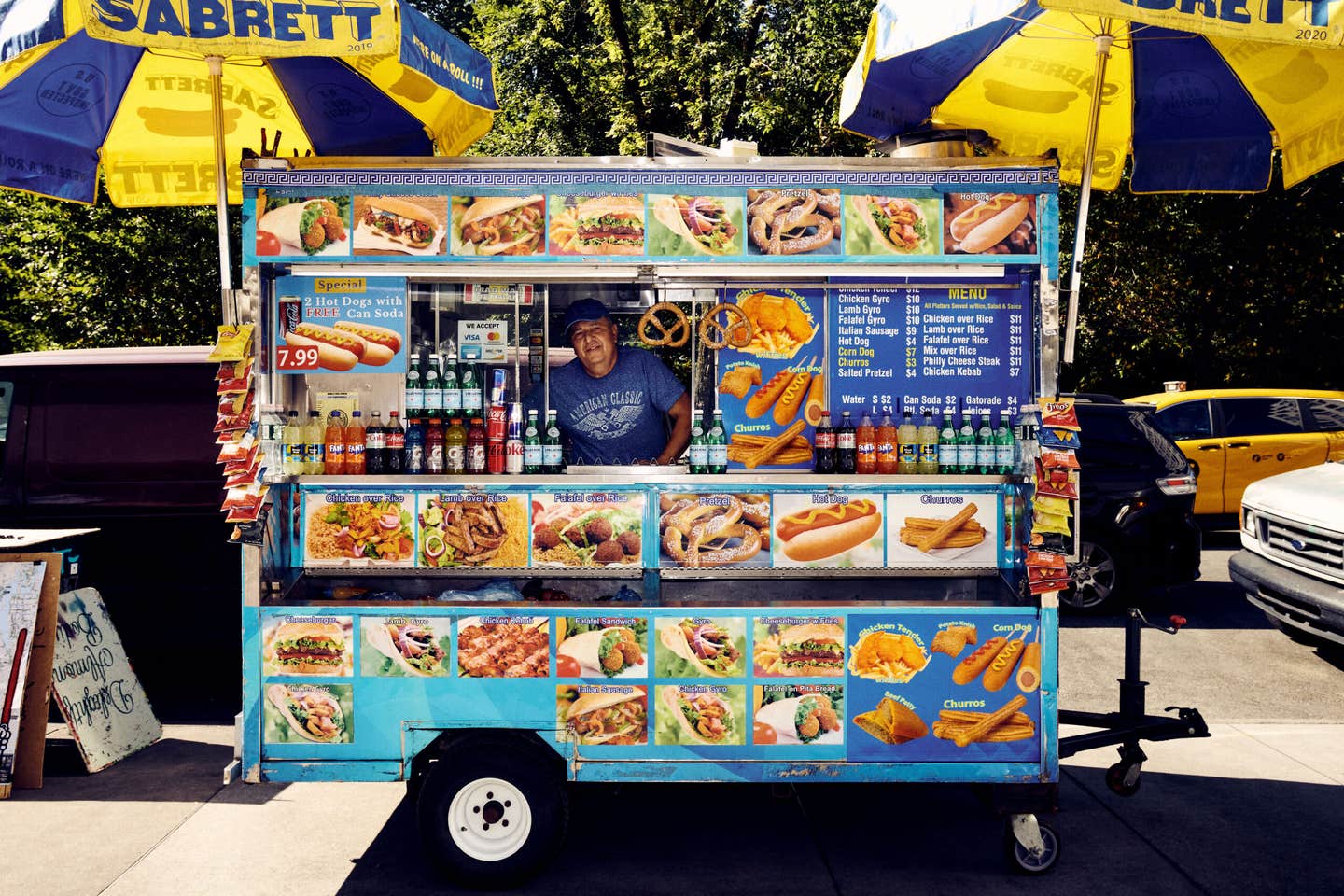
On Saturday mornings, you have to wait for what seems like an eternity to place your order at the deli counter in Bobak's, a Polish supermarket out by Midway Airport, on Chicago's Southwest Side. And when the woman behind the counter calls your number in Polish, you'd better know exactly what you'd like, lest she catch someone else's eye and move on. During my first visit, I got passed over for a man with a handlebar mustache who asked for four samples of different sausages before requesting a mere pound of one. Then a young woman muscled forth, pointing to the chunk of smoked pork butt she wanted to take home. When I finally worked up the nerve, I carefully asked for boczek myśliwski, or hunter-style bacon. (I'd rehearsed the pronunciation—boh-CHECK mish-LIV-ski—a few dozen times in my head beforehand.) The worker surprised me by answering in crisp English, "Do you want that sliced or slab?"
I had come to Chicago to taste the many things the city's famous Polish delis and butchers do with pork, and I was getting off to a good start. When I cooked it up later that afternoon, the bacon—double smoked and meaty, with ribbons of aromatic fat that melted on the tongue—was unlike anything I'd eaten. Returning to Bobak's the next day, I gazed at dozens of varieties of kielbasa dangling from hooks behind the counter, some reddish with crinkled rinds, others in slender loops, and still others labeled with signs that indicated regional provenance (krakowska, poznanska, and so on). When I was a kid growing up on Long Island, in New York, my Polish grandfather never hinted that a world existed beyond the Hillshire Farm kielbasa we ate with Mrs. T's pierogi. Years later, I got the occasional taste of better Polish sausage (made with natural casings, sparkling with spice, free of fillers) from New York City's Polish delis and on visits to Poland, but it wasn't until my sister moved to Chicago and I started pork shopping there that I fully realized what I'd been missing.
In Avondale, a neighborhood in northwestern Chicago that's known by local Poles as Jackowo, and in other Polish enclaves, there are tiny delis, like Stanley Sausage Shop and Liquor on West Belmont Avenue, that make meats such as polędwica, a satiny, smoked pork loin. Along Milwaukee Avenue—a major artery, lined with Polish businesses, that extends diagonally across the city's northern reaches—are scores of butchers and grocers, each with a particular specialty: at Staropolska, for example, it's smoked ribs smothered with caramelized onions, from a recipe that the butcher Ludwig Jacek says he developed while learning the art of smoking meats in the Polish city of Opole. And on the fringes of Chicago and in the suburbs, where more than half of the state's roughly 900,000 citizens of Polish ancestry (a majority of them first generation) live, you can find supermarkets connected to sausage factories where meaty stuffed cabbage rolls and peppery pork burgers are sold from behind steam table counters and where traditional Polish butchery—from headcheeses to pork ears—is the norm. Beholding all this and more, I marveled at the fact that the poet Carl Sandburg's famous moniker for Chicago—"Hog Butcher for the World"—rings so enduringly true.
Stan Bobak, the 43-year-old owner of Bobak's Sausage Company, knows how to woo a lover of the pig. "This is the good stuff," he said, handing me a piece of kabanos, a crinkled, slender sausage that delivered a taste of pepper and caraway. Even though Bobak's—which offers around a hundred varieties of meats and sausages—sells shrink-wrapped kielbasa for 99 cents a pound, it also makes sausage the old-fashioned way, allowing it to air-cure in unrefrigerated rooms. "There are rules in this country that prohibit this," Stan told me, "but here in Chicago, everyone just looks the other way."
We were walking through the maze of rooms where the sausage is made—one for seasoning and grinding various cuts of pork, another in which 20 or so men twist the sausages into links, and yet another containing the heart of the operation: the 15-foot-high smokers in which most of the meats from Bobak's undergo their transformation. Bags of wood chips were arranged against the wall, as were stacks of oak logs, used for the slow, low-temperature smoking that yields intensely flavorful meat. This is what Bobak's is famous for: the heavily smoked bacons and sausages that are typical of Poland's southern highlands.
Talk with Stan Bobak long enough, and sooner or later the conversation rolls around to Zakopane, the town in the mountainous highland region near Poland's Czech border where his father was born. Chicago's Highlander community is a tight one, he told me, and has long relied on the social clubs and organizations that help new immigrants get situated and find jobs. When Stan's father, Frank, came over in the 1960s, he found work, as many Poles did, in the city's vast stockyards, where a majority of the country's pork was processed or distributed at the time, and he moved the family to the nearby neighborhood known as Back of the Yards. At night, Frank would make small batches of sausage in his garage, setting the links and coils in a small brick smoker.
Eventually the family opened a deli in Jackowo, followed by several others around town. In 1975 the Bobaks bought their first plant and started wholesaling, and in 1989 they built the store and factory where we were standing now. The neighborhood, known as Garfield Ridge, has a large Highlander population. "In a way," Stan said, "it felt like we were coming home."
Stella, Stan's wife—who was born near Zakopane and met Stan in a Highlander dance class when they were in their teens—told me that she rarely makes dishes that don't include pork in one way or another, whether it's the rib meat in żurek, a rye-flour soup, or the smoked pork shoulder in bigos, Poland's ubiquitous sauerkraut stew, which is served in the restaurant attached to the Bobak's store. "Our food is home style," Stella said, "but if you want to try something upscale, go to Szalas, down the block."
At that Archer Avenue restaurant, named for a traditional mountain chalet, I had a pork cutlet wrapped in bacon along with flatbreads slathered with lard and pork cracklings. I was in hog heaven.
To what delicious ends do Chicago's Polish home cooks use these cured and smoked meats? "You should come to our ball and ask them!" said Jan Lorys, director of the city's Polish Museum of America, located on Milwaukee Avenue, when I called to inquire about the culinary material in his archives. The museum's annual black-tie event, held in a ballroom of the Chase Tower in the Loop, attracted more than 300 people. When I got there, Lorys, a tall, white-haired man, showed me around, introducing me to this person whose mother used to work in the stockyards and that person who was a fabulous cook. At one point, he sent me off to a corner to speak with a kindly wallflower of a historian named Joseph Zurawski, who mapped out a genealogical tree of the city's prominent sausage families. "Slotkowski was the first famous one," he said. That business, he added, started in 1918 and was bought by Leon's Sausage, which recently became Sausages by Amy, known around the country for its antibiotic-free, all-natural meat. Then there's Mikolajczyk, who sold to a butcher named Andy Kolasa, who in turn opened a flashy, new supermarket on the North Side called Andy's Deli.
Zurawski and I also talked about Bobak's, which experienced rapid growth in the late 1990s and expanded by opening glitzy suburban superstores. After Frank Bobak retired, about a decade ago, Stan, who managed the original location, and his brothers, who operated the suburban ones, became involved in a highly publicized family feud. Most of the suburban supermarkets have since closed. "It's been hard on Polonia," a Polish radio announcer, sitting next to me at the dinner table, said about the dispute's effect on Chicago's Polish community, often known collectively as Polonia. "But Bobak's sausage is still very good."
The next day, I set out to find a few of the establishments that people had recommended the night before. When I asked to speak with the butcher at the Krakus deli, far out on Milwaukee Avenue in the Jefferson Park neighborhood, Robert Bielowicz poked his head out of a doorway in back and waved me in. "It's all about how you sort the meat," he said a bit later, explaining that each sausage is a carefully calibrated composition of cuts chosen for taste, texture, and fat. Bielowicz, a third-generation butcher who still works with his father, a Krakow native, knows exactly how much sausage his regular customers will buy each week: usually about a thousand pounds. His prices are a little higher than those of the large sausage makers I visited, which he attributes to his being picky about his pork and the quality of his raw garlic and other ingredients. There's far less variety in his simply appointed shop, but everything I tasted—the ham coated in garlic and herbs, the air-dried kabanos—had a pure, handcrafted character.
On the last day of my visit, I returned to Bobak's for lunch. The 120-seat cafeteria-style restaurant adjacent to the supermarket was crowded with customers filling their plates at the hot buffet. There were mini aspics studded with herbs and ham, crepes filled with shredded pork, and bacon-wrapped pork loin. Ah, the joys of lunch at a butcher shop, I thought.
I flagged down Stan. I was eager to tell him about a conversation I'd had the day before. A woman I'd met at the Polish Museum who worked for a Polish food distributor swore that the sausages you find in Chicago are superior in flavor to those you can find in many areas of Poland. Stan replied with typical, understated equanimity. "Here in Chicago," he said, "Poles really cling to their heritage to keep it alive."
As I was leaving, he told me to look for his sausage in Brooklyn, where I live and where he ships a few times a week. Even the air-cured stuff? I asked.
"No," he said. "For that, you'll have to come back to Chicago."
Keep Reading
Continue to Next Story










